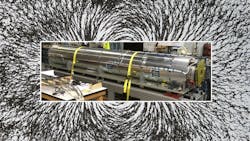National Labs Build Largest Focusing Magnet for Accelerators
A trio of national U.S. labs have built and tested a powerful new magnet based on an advanced superconducting material. The eight-ton magnet—about as long as a semi-truck trailer—set a record for having the highest field strength for an accelerator focusing magnet. It sets a new standard for magnets operating in high-energy particle colliders.
Engineers at Doe’s Fermilab, Brookhaven and Lawrence Berkeley National Laboratories designed, built and tested the magnet, one of 16 they will provide for operation in the High-Luminosity Large Hadron Collider (LHC) at CERN Laboratory in Europe. The 16 magnets, along with another eight produced by CERN, serve as “optics” for charged particles. They will focus beams of protons into a small, infinitesimal spot as they approach collision inside a pair of particle detectors.
The magnet is made of niobium-tin, a superconducting material that creates strong magnetic fields. It will be the first niobium-tin quadrupole magnet to operate in a particle accelerator.
Like the current LHCL, its high-luminosity successor will smash together beams of protons running around the 17-mile ring at close to the speed of light. The High Luminosity LHC will provide 10 times the number of collisions that are possible at the current LHC. More collisions will give physicists more opportunities to discover new physics.
In circular colliders such as CERN, two beams of particles race around the ring in opposite directions. Just before they collide, each beam passes through a series of magnets that focus the particle beams into a smaller one, much the way lenses focus light rays to a point. The beams become denser, packed as tightly with particles as the magnets can get them before the beams collide. The more particles crowded into the collision point, the greater the chance of particle collisions.
To focus the beams, the magnet had to gerent a field greater than 11.4 teslas. That would be big jump from the current 7.5-tesla field generated by the niobium-titanium-based LHC quadrupole magnets. (For accelerator experts: The HL-LHC integrated luminosity goal is 3,000 inverse femtobarns.)
In January, the three-lab team’s first HL-LHC focusing magnet generated a 11.5-tesla field for five straight hours, just as it would operate when the High-Luminosity LHC starts up in 2027.The focusing magnets in the current LHC are made with niobium-titanium, whose intrinsic performance limit is recognized to have been reached at 8 to 9 teslas in an accelerators.
Sending enough electrical current through a niobium-tin superconductor can generate magnetic fields of 12 teslas and higher, but only if the niobium and tin, once mixed and heat-treated, remain intact.
From now until about 2025, the labs will continue to build the large magnet. They plan to begin delivering the first of 16 magnets, plus four spares, to CERN in 2022. Installation will take place over the three following years.

